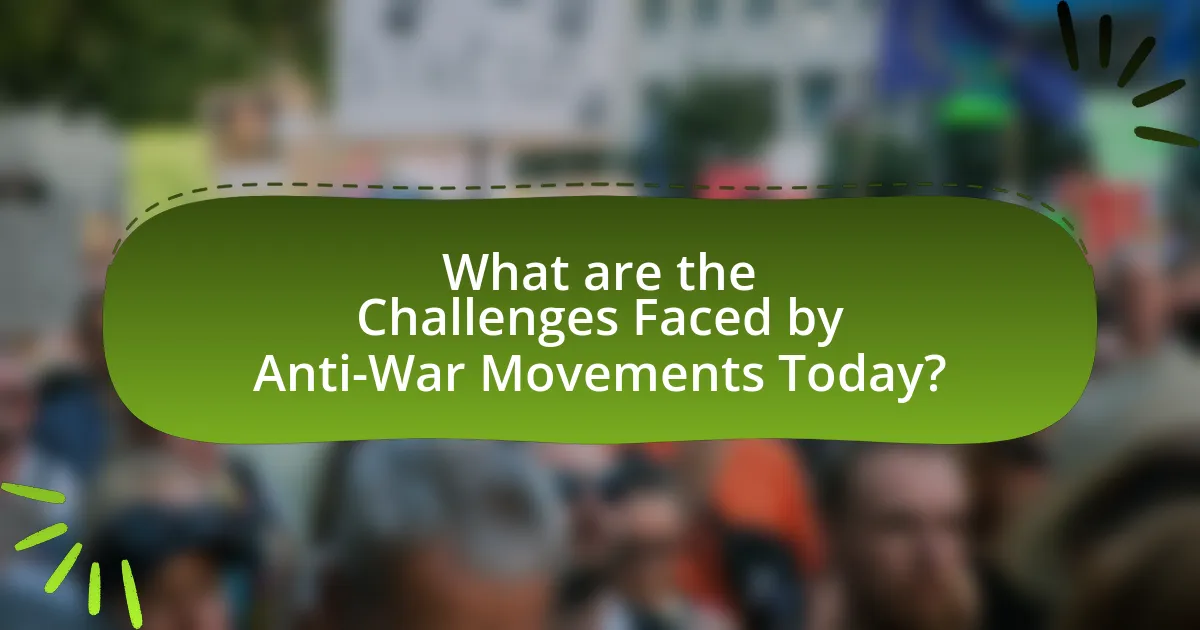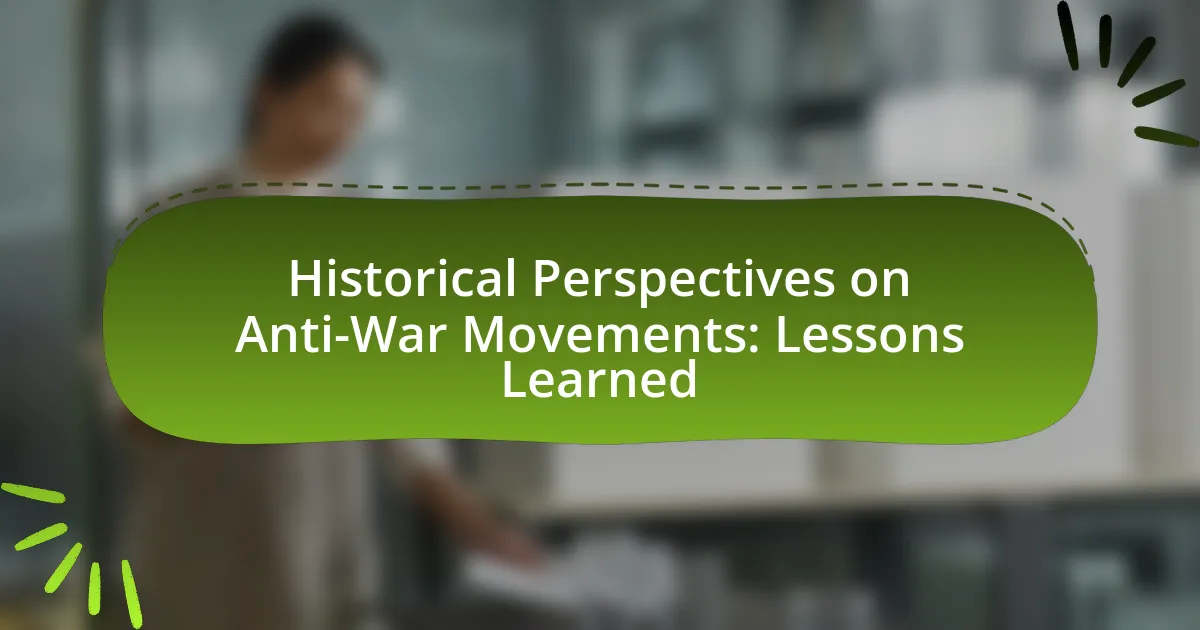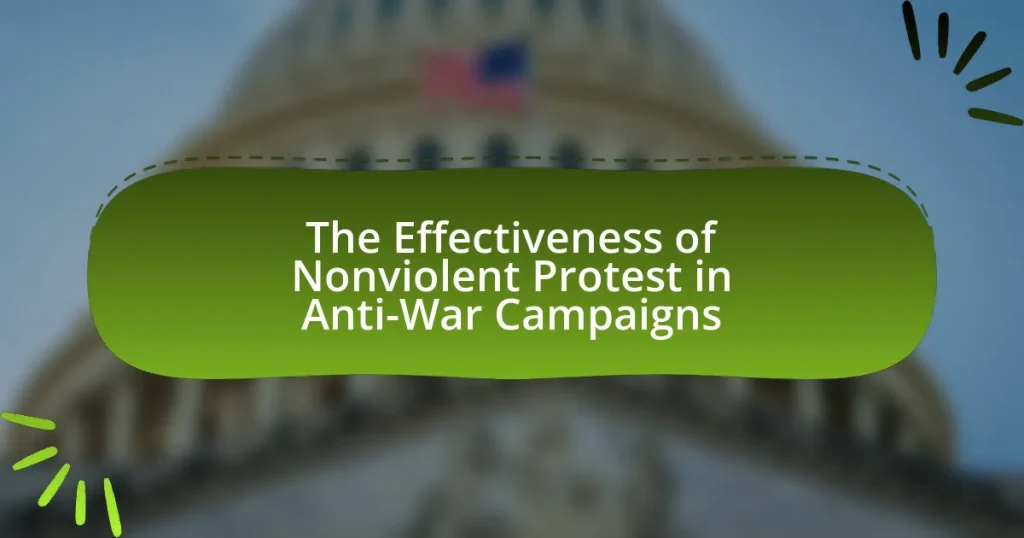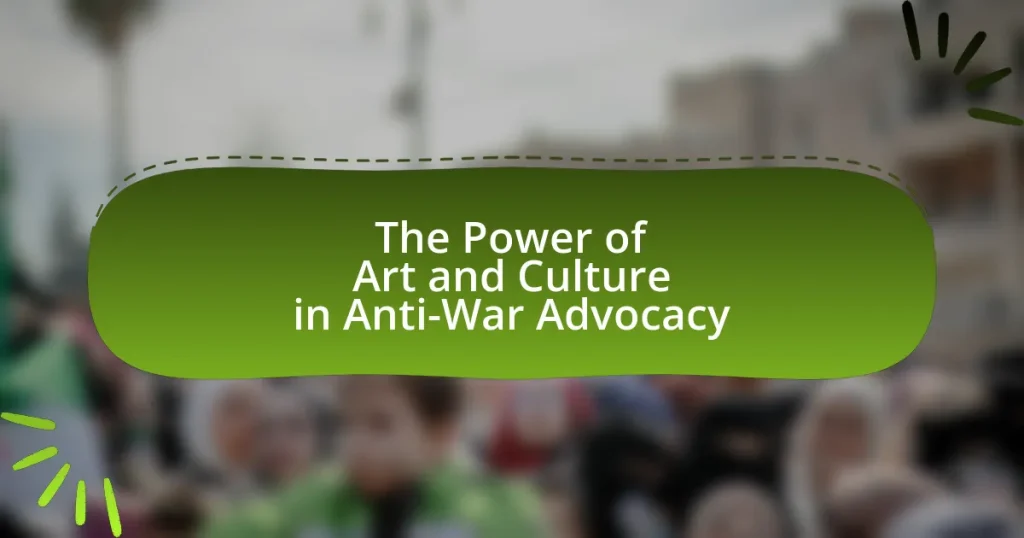Anti-war movements are organized efforts opposing military conflict and advocating for peace, with historical roots in significant wars such as the Vietnam War, Gulf War, and Iraq War. These movements have evolved from localized protests to global coalitions, employing strategies like grassroots organizing, public demonstrations, and coalition-building to influence public opinion and policy. Key historical events and societal attitudes have shaped these movements, highlighting their goals of promoting social justice and preventing military conflict. The article explores the lessons learned from past anti-war movements, their impact on contemporary activism, and the challenges faced today, emphasizing the importance of effective communication and coalition-building in achieving their objectives.

What are Anti-War Movements and Their Historical Context?
Anti-war movements are organized efforts by individuals and groups to oppose military conflict and advocate for peace. Historically, these movements have emerged in response to specific wars, such as the Vietnam War in the 1960s and 1970s, where widespread protests highlighted public dissent against U.S. involvement, leading to significant political and social change. The anti-war movement during this period was characterized by mass demonstrations, cultural expressions, and a strong emphasis on civil rights, reflecting broader societal concerns about government transparency and military ethics. These movements have played a crucial role in shaping public discourse on war and peace, influencing policy decisions and fostering a culture of activism that persists in contemporary society.
How have anti-war movements evolved over time?
Anti-war movements have evolved significantly over time, transitioning from localized protests to global coalitions. Initially, during the American Civil War and World War I, anti-war sentiments were often expressed through pamphlets and small gatherings. The Vietnam War era marked a pivotal shift, as mass protests, organized by groups like Students for a Democratic Society, utilized media coverage to amplify their message, leading to widespread public dissent. In the 21st century, movements against wars in Iraq and Afghanistan leveraged social media platforms, enabling rapid mobilization and international solidarity, as seen in the global protests of 2003. This evolution reflects a growing sophistication in strategies and communication methods, adapting to technological advancements and changing political landscapes.
What key historical events have influenced the rise of anti-war movements?
Key historical events that have influenced the rise of anti-war movements include the Vietnam War, the Gulf War, and the Iraq War. The Vietnam War, particularly the Tet Offensive in 1968, galvanized public opposition in the United States, leading to widespread protests and the formation of organizations like Students for a Democratic Society. The Gulf War in 1990-1991 saw significant anti-war activism, with protests organized by groups such as the National Mobilization Against the War. The Iraq War, initiated in 2003, sparked global protests, with millions participating in demonstrations worldwide, highlighting the impact of perceived unjust wars on public sentiment. These events collectively illustrate how military conflicts can provoke significant grassroots movements advocating for peace and accountability.
How did societal attitudes towards war shape these movements?
Societal attitudes towards war significantly influenced anti-war movements by fostering a collective consciousness that questioned the morality and necessity of military conflict. For instance, during the Vietnam War, widespread public disillusionment with government narratives and the human cost of war galvanized protests, as seen in events like the Kent State shootings in 1970, which highlighted the growing opposition among citizens. This shift in perception was further evidenced by the increasing participation of diverse groups, including students, veterans, and civil rights activists, who united under a common goal to advocate for peace and challenge militaristic policies. The impact of these movements was profound, leading to policy changes and a reevaluation of military engagement in subsequent conflicts, demonstrating how societal attitudes can reshape political landscapes.
What are the main goals of anti-war movements?
The main goals of anti-war movements are to advocate for peace, prevent military conflict, and promote social justice. These movements aim to raise public awareness about the consequences of war, including loss of life, economic hardship, and social disruption. Historically, anti-war movements, such as those during the Vietnam War, mobilized large segments of society to challenge government policies and military actions, emphasizing the need for diplomatic solutions over armed conflict. For instance, the Vietnam War protests in the 1960s and 1970s significantly influenced public opinion and led to policy changes, demonstrating the effectiveness of grassroots activism in shaping national discourse on war.
How do these goals vary across different movements and eras?
Anti-war movement goals vary significantly across different movements and eras, reflecting the specific sociopolitical contexts and conflicts involved. For instance, the anti-Vietnam War movement in the 1960s primarily aimed to halt U.S. military involvement in Vietnam, driven by widespread public discontent and the moral implications of the war, as evidenced by protests and significant events like the Kent State shootings in 1970. In contrast, the more recent anti-war movements, such as those opposing the Iraq War in the early 2000s, focused on issues like the justification for war, the humanitarian impact, and the consequences of military intervention, highlighted by large-scale protests in cities worldwide. Each movement’s goals were shaped by the unique historical circumstances, public sentiment, and the specific wars being contested, demonstrating how anti-war objectives evolve in response to changing political landscapes and societal values.
What strategies do anti-war movements employ to achieve their objectives?
Anti-war movements employ strategies such as grassroots organizing, public demonstrations, lobbying, and coalition-building to achieve their objectives. Grassroots organizing mobilizes community members to raise awareness and foster local support, exemplified by the Vietnam War protests where local groups coordinated large-scale demonstrations. Public demonstrations serve to visibly express dissent and attract media attention, as seen in the 2003 protests against the Iraq War, which drew millions globally. Lobbying efforts target policymakers to influence legislation and public opinion, demonstrated by organizations like Peace Action advocating for disarmament. Coalition-building unites various groups, enhancing collective power and reach, as evidenced by the diverse alliances formed during the anti-nuclear movement in the 1980s. These strategies collectively aim to shift public perception and pressure governments to reconsider military actions.

What Lessons Can Be Learned from Historical Anti-War Movements?
Historical anti-war movements demonstrate the power of collective action in influencing public opinion and policy. For instance, the Vietnam War protests in the 1960s and 1970s significantly swayed American sentiment against the war, leading to a shift in government policy and eventual withdrawal. These movements highlight the importance of grassroots organizing, as seen in the mobilization of diverse groups, including students, veterans, and civil rights activists, who united to challenge military engagement. Additionally, they reveal the effectiveness of various forms of protest, such as marches, sit-ins, and media campaigns, in raising awareness and fostering dialogue about the consequences of war. The lessons learned emphasize the need for sustained advocacy, the role of empathy in building coalitions, and the impact of leveraging media to amplify voices against conflict.
How have past anti-war movements influenced contemporary activism?
Past anti-war movements have significantly influenced contemporary activism by establishing frameworks for grassroots organizing, coalition-building, and the use of digital platforms for mobilization. The Vietnam War protests of the 1960s and 1970s exemplified how mass mobilization could challenge government policies and shape public opinion, leading to increased awareness and activism around issues such as military intervention and social justice. These historical movements demonstrated the effectiveness of nonviolent resistance and civil disobedience, which contemporary activists continue to employ in various contexts, including climate change and racial justice movements. Additionally, the strategies developed during past movements, such as the use of art and media to convey messages, have been adapted to modern platforms, enhancing outreach and engagement.
What successful tactics from historical movements can be applied today?
Successful tactics from historical movements that can be applied today include grassroots organizing, nonviolent resistance, and coalition-building. Grassroots organizing, as seen in the Civil Rights Movement, mobilizes local communities to advocate for change, fostering a sense of ownership and empowerment. Nonviolent resistance, exemplified by Mahatma Gandhi’s campaigns, effectively draws attention to injustices while minimizing backlash. Coalition-building, demonstrated during the Vietnam War protests, unites diverse groups to amplify voices and broaden support. These tactics have proven effective in creating social change and can be adapted to contemporary anti-war efforts.
What mistakes from past movements should current activists avoid?
Current activists should avoid the mistake of failing to build broad coalitions, as seen in past movements like the Vietnam War protests, where fragmentation weakened their impact. Historical evidence shows that inclusive strategies, such as those employed by the Civil Rights Movement, led to greater success by uniting diverse groups around common goals. Additionally, activists should refrain from relying solely on social media for mobilization, as the anti-globalization protests of the early 2000s demonstrated that on-the-ground organizing is crucial for sustained engagement and visibility.
What role does public perception play in the effectiveness of anti-war movements?
Public perception significantly influences the effectiveness of anti-war movements by shaping public support and political pressure. When a substantial portion of the population opposes a war, as seen during the Vietnam War, this widespread dissent can lead to increased media coverage, which amplifies the movement’s message and attracts more participants. Historical evidence shows that public protests, such as the 1969 Moratorium to End the War in Vietnam, drew millions and pressured policymakers to reconsider military strategies. Additionally, favorable public perception can lead to legislative changes, as seen when Congress curtailed funding for the Vietnam War in response to growing anti-war sentiment. Thus, public perception acts as a catalyst for mobilization and policy change within anti-war movements.
How can movements shape or change public opinion about war?
Movements can shape or change public opinion about war by mobilizing grassroots activism, raising awareness, and influencing media narratives. For instance, the Vietnam War protests in the 1960s and 1970s significantly shifted public sentiment against the war, as large-scale demonstrations and organized campaigns highlighted the human costs and moral implications of military involvement. Research indicates that these movements effectively utilized media coverage to amplify their messages, leading to a decline in public support for the war, as evidenced by a Gallup poll in 1971 showing that only 28% of Americans approved of U.S. involvement in Vietnam. This illustrates how collective action and strategic communication can alter perceptions and foster a critical dialogue about military conflicts.
What impact does media coverage have on the success of anti-war initiatives?
Media coverage significantly enhances the success of anti-war initiatives by amplifying public awareness and mobilizing support. Historical examples, such as the Vietnam War protests, demonstrate that extensive media reporting on civilian casualties and anti-war demonstrations galvanized public opinion against the war, leading to increased activism and political pressure on government officials. Studies indicate that media framing of anti-war narratives can shape perceptions, influencing both public sentiment and policy decisions. For instance, the coverage of the My Lai Massacre in 1969 played a crucial role in shifting public attitudes, ultimately contributing to the withdrawal of U.S. troops from Vietnam. Thus, effective media coverage serves as a catalyst for anti-war movements, fostering greater engagement and advocacy.

What are the Challenges Faced by Anti-War Movements Today?
Anti-war movements today face significant challenges, including political polarization, misinformation, and the influence of social media. Political polarization has led to a divided public, making it difficult for anti-war activists to unite diverse groups under a common cause. Misinformation campaigns, often propagated through social media platforms, distort public perception of conflicts and undermine the credibility of anti-war arguments. Additionally, the rapid spread of information can overwhelm activists, making it challenging to convey clear, factual narratives. According to a 2021 study by the Pew Research Center, 64% of Americans believe misinformation is a major problem in political discourse, highlighting the impact of false narratives on public opinion regarding war.
How do modern anti-war movements differ from those of the past?
Modern anti-war movements differ from those of the past primarily in their use of technology and global connectivity. Contemporary movements leverage social media platforms to organize, mobilize, and disseminate information rapidly, allowing for broader participation and real-time engagement. For instance, the anti-war protests against the Iraq War in 2003 utilized online platforms to coordinate actions and share messages, reaching millions globally, unlike earlier movements that relied heavily on traditional media and in-person gatherings. Additionally, modern movements often emphasize intersectionality, addressing not only war but also related issues such as climate change, social justice, and human rights, reflecting a more holistic approach compared to the more singular focus of past movements, such as those during the Vietnam War era.
What new obstacles do contemporary movements encounter?
Contemporary movements encounter obstacles such as digital surveillance, misinformation, and political polarization. Digital surveillance has increased with governments monitoring online activities, which can deter participation and stifle dissent. Misinformation campaigns, often spread through social media, can distort public perception and undermine the credibility of movements. Political polarization further complicates the landscape, as movements face backlash from opposing factions, making it difficult to build broad coalitions. These challenges reflect a shift in the dynamics of activism, where technology and societal divisions play significant roles in shaping the effectiveness of contemporary movements.
How has technology changed the landscape of anti-war activism?
Technology has significantly transformed the landscape of anti-war activism by enhancing communication, mobilization, and awareness. The rise of social media platforms, such as Twitter and Facebook, has enabled activists to disseminate information rapidly, organize protests, and connect with a global audience. For instance, during the Iraq War, online campaigns like “Not In Our Name” utilized digital tools to rally support and share anti-war messages, reaching millions in a matter of hours. Additionally, technology has facilitated the documentation of war atrocities through smartphones and video-sharing platforms, allowing activists to present undeniable evidence of the impacts of war, which has influenced public opinion and policy decisions. This shift towards digital activism has made it easier for grassroots movements to gain traction and for individuals to participate in anti-war efforts from anywhere in the world.
What strategies can modern anti-war movements adopt for greater impact?
Modern anti-war movements can adopt strategies such as leveraging social media for widespread awareness and mobilization. By utilizing platforms like Twitter and Facebook, these movements can disseminate information rapidly, engage younger audiences, and create viral campaigns that highlight the consequences of war. Historical examples, such as the Vietnam War protests, demonstrate that grassroots organizing combined with effective communication can significantly influence public opinion and policy. Additionally, forming coalitions with other social justice movements can amplify their message and create a unified front against militarism, as seen in the collaboration between anti-war activists and civil rights organizations during the 1960s.
How can coalitions with other social movements enhance effectiveness?
Coalitions with other social movements enhance effectiveness by pooling resources, amplifying voices, and creating a unified front that can exert greater pressure on decision-makers. For instance, during the Vietnam War, various anti-war groups collaborated with civil rights organizations, which not only broadened their base of support but also highlighted the intersectionality of issues such as racial injustice and militarism. This collaboration led to larger demonstrations and increased media attention, ultimately influencing public opinion and policy. Historical evidence shows that movements that unite across different social issues can achieve more significant legislative changes and societal impact than those that operate in isolation.
What role does grassroots organizing play in current anti-war efforts?
Grassroots organizing is crucial in current anti-war efforts as it mobilizes communities to advocate for peace and influence policy. This form of organizing empowers individuals to engage in collective action, fostering a sense of agency and solidarity among participants. For instance, organizations like Code Pink and Veterans for Peace utilize grassroots strategies to raise awareness, organize protests, and lobby against military interventions. Research indicates that grassroots movements can significantly impact public opinion and political decision-making, as seen in the widespread protests against the Iraq War in the early 2000s, which contributed to a decline in support for military action. Thus, grassroots organizing serves as a foundational element in shaping the discourse around war and peace, driving both local and national initiatives.
What practical steps can individuals take to support anti-war movements?
Individuals can support anti-war movements by actively participating in protests and demonstrations, which have historically shown to raise awareness and influence public opinion. Engaging in grassroots organizing, such as forming or joining local activist groups, allows individuals to collaborate on campaigns that advocate for peace and conflict resolution. Additionally, individuals can educate themselves and others about the consequences of war through workshops, discussions, and distributing literature, which helps to inform and mobilize communities. Supporting organizations that focus on anti-war efforts, such as the American Friends Service Committee, can amplify their impact through donations or volunteer work. Furthermore, contacting elected representatives to express opposition to military actions and advocating for diplomatic solutions can influence policy decisions. These actions are supported by historical evidence showing that sustained public pressure can lead to significant political change, as seen during the Vietnam War protests, which contributed to shifts in U.S. foreign policy.



